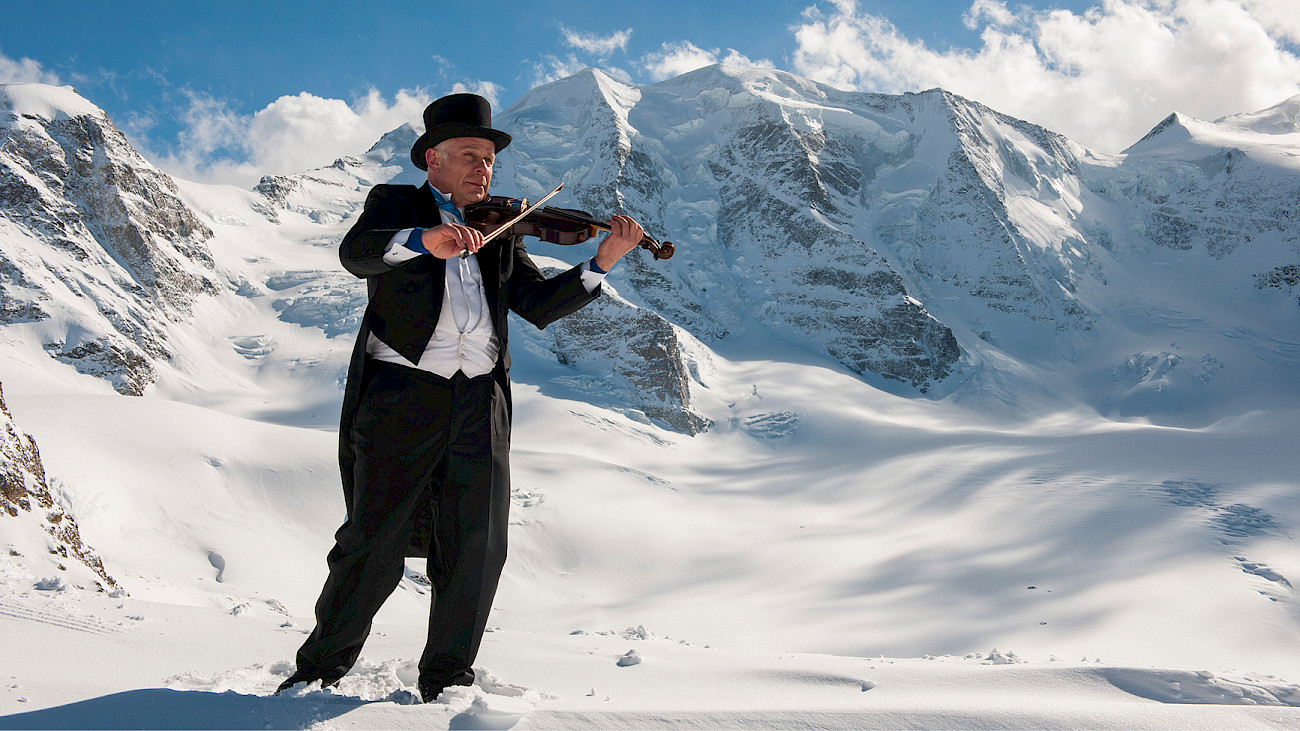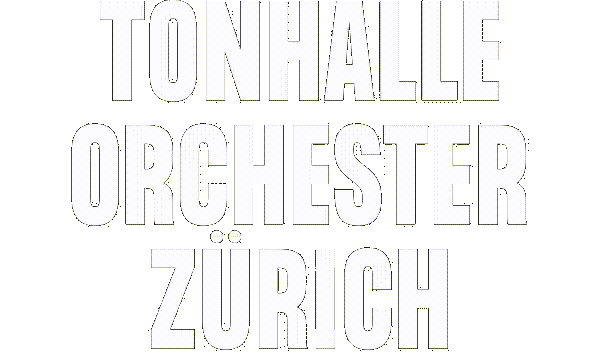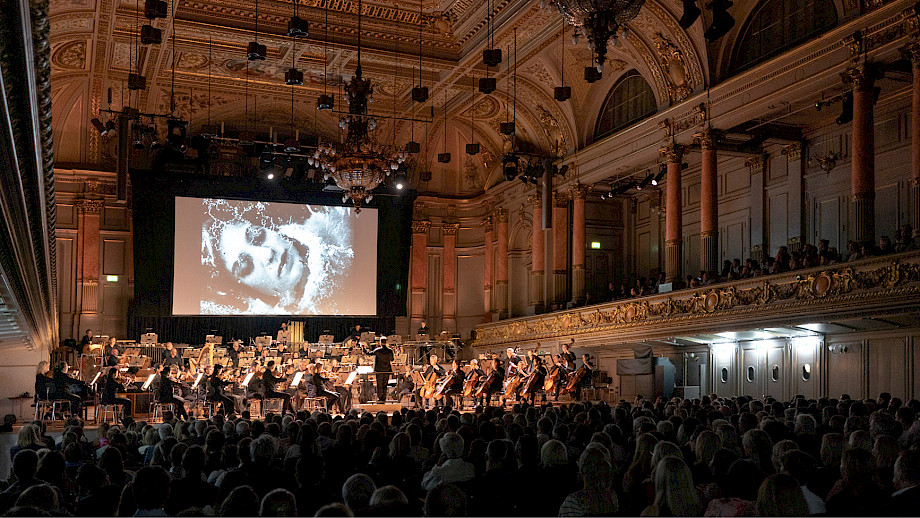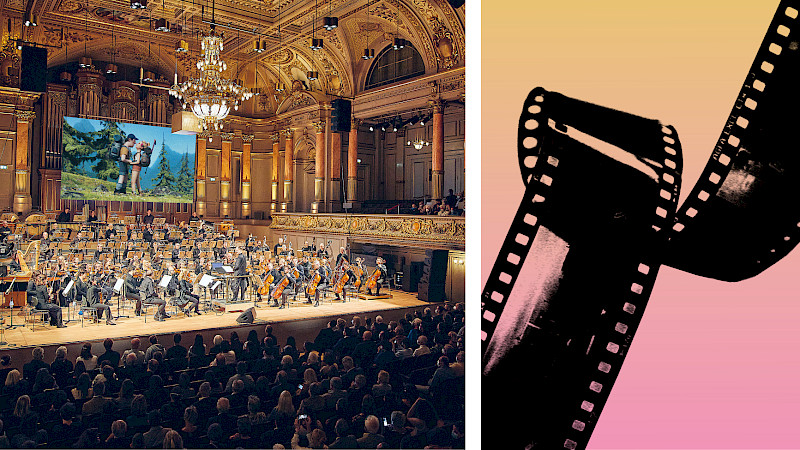
Violins against the melting glacier
Felix Keller is a scientist and grew up in the Upper Engadine near Piz Palü. However, the mountain also plays an important role beyond his work.
Piz Palü is part of the Bernina Group. What expectations do people have when they climb this mountain?
When you set off in the morning and see the three peaks and the mountain ridge, you think you'll never make it to the summit. However, Piz Palü is not an overly difficult mountain to climb. With the right training and the help of a mountain guide, even non-professionals can make it up the almost four-thousand-metre peak. I know some people who set themselves the personal goal of climbing Piz Palü one day, and they still manage to do it at the age of 70. Standing on the summit is the highlight of an encounter with nature, and the view down to St. Moritz, Pontresina and Italy is incredibly beautiful.
You are a glaciologist and work in permafrost, snow and glacier research. In addition to other tasks at ETH Zurich, you lead numerous excursions around Piz Palü. Are you also a mountain guide?
No, I've only been to the summit once myself. I'm a qualified professional hiking guide and in this capacity I organise popular scientific adventure excursions, also with the violin, by the way.
You are also a very committed amateur musician, and Piz Palü plays an important role here. Please tell us.
I give outdoor concerts with the Swiss Ice Fiddlers, an ensemble with a variable line-up. And with TangoGlaciar: this consists of myself and a Dutch glaciologist from the MortAlive glacier project, where we are investigating methods for the delayed melting of glaciers. I regularly take part in Harald Haugaard's International Fiddle School in northern Germany with my wife. When we played Nordic folk music on a dyke in Husum a few years ago, I immediately had an image of performing a concert at the foot of Piz Palü. I told the others on the course about our melting glaciers. As a result, 53 participants of the Fiddle School spontaneously agreed to perform the first glacier concert on 13 October 2018 at the place where the Föhn storm swirls in the film "The White Hell of Piz Palü". We all felt the power of music to mobilise people for the endangered glacier world. That was the starting point for my concerts in the mountains. Incidentally, Ursula Sarnthein, the violist of the Tonhalle-Orchester Zürich, has recently started travelling with us. I really enjoy going to her for violin lessons because she is a great role model for me.
The film "The White Hell of Piz Palü", which we are showing in our film symphony series, was released in 1929. In the film, Maria and Hans make love in a straw bed in the simple stone hut on the Diavolezza. Today, the Berghaus Diavolezza is a place that leaves nothing to be desired for its guests. An example of how tourism in this region has changed in recent years. How do you perceive this?
I myself worked at the Tuoi hut of the Alpine Club at the foot of Piz Buin 35 years ago and know what it means to be away from civilisation. We often think that things used to be less hectic and simply more cosy. I think that's a misconception. I think the problem is that we always take on too much. I'm definitely one of those people and I feel like I'm running out of time. We still have to learn the same thing: become a little more modest, live more contemplatively, perhaps only be satisfied with half of what we have and then realise that this is actually fine.
Do you have a Far Eastern background?
Yes, perhaps. Or it's an experience you have in the mountains. When you're on a mountain, far away from civilisation, you start to think about the bigger picture. Whatever that means.
Can you remember your first encounter with the film?
I still remember the scenes with the aeroplane flying over the glacier and the couple in the Diavolezza hut, who I know very well. The accident and rescue scenes are impressive.
Last summer, the SRF-DOK film "Todesfalle Haute Route" received an award for outstanding films about alpinism at the Les Diablerets Mountain Film Festival. Why do mountain films still have great appeal?
When I'm asked about glacier shrinkage, I often reply that I feel glaciers are part of the Swiss national soul. They belong to us like the mountains. We associate many emotions with the mountains, which they trigger through their beauty or their terror – and the adrenaline that they trigger in us. This tension creates a triangle. When I watch mountain films, I notice that these three aspects are almost always present and I pay attention to how they relate to each other.
"The white hell of Piz Palü"
The silent film "The White Hell of Piz Palü" was a great cinema success in 1929/30. The film is set in the present day on the eponymous mountain in the Bernina Group. Maria (the young Leni Riefenstahl) and Hans (Ernst Petersen) have recently got married. Full of anticipation, they retreat to the mountain hut on the Diavolezza. Their togetherness is soon disturbed, however, because a certain Dr Johannes Krafft (Gustav Diessl) is also drawn to the enigmatic mountain world. He has tried to climb Piz Palü alone several times in the past in order to come to terms with the death of his wife, also called Maria, who died in an accident. Hans' Maria is attracted to the taciturn newcomer. Together with Johannes, the couple set off the next day for the north face of Piz Palü. A group of students with mountaineering experience are also on their way and a trial of strength begins, which ends tragically.
The real starring role in the mountain drama "The White Hell of Piz Palü" is played by the landscape, which also looks spectacular in black and white. Filming took five months in the icy Bernina massif. Georg Wilhelm Pabst was responsible for the interior filming and advised Arnold Fanck on the dramaturgy, who was the second director in charge of filming in the mountains. The outdoor shots in natural light and dangerous terrain and weather conditions with heavy and bulky camera equipment were extremely risky. Riefenstahl reported how exhausted she was by the shooting conditions and "the brutality of my director".
"The White Hell of Piz Palü" founded the successful mountain film genre. It is not without controversy: Leni Riefenstahl and aerobatic pilot Ernst Udet made great careers in Hitler's Nazi regime in the years that followed. The film was retroactively Nazified in 1935: For a shortened German sound version, the scenes with the well-known Jewish actor Kurt Gerron were removed. Quentin Tarantino quoted "The White Hell of Piz Palü" in his film "Inglourious Basterds" (2009) in a scene in a Paris cinema during the Nazi occupation. The Tages-Anzeiger assessed this reminiscence as follows: "Tarantino presents 'Die weisse Hölle vom Piz Palü' as a Nazi-compliant German cultural export and cinematic masterpiece at the same time."
We are now showing the silent film in its original version with the film music by Ashley Irwin (1997/98). (KJ)
Translated with DeepL.com





